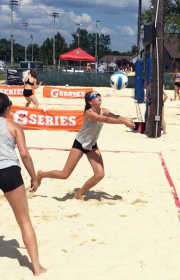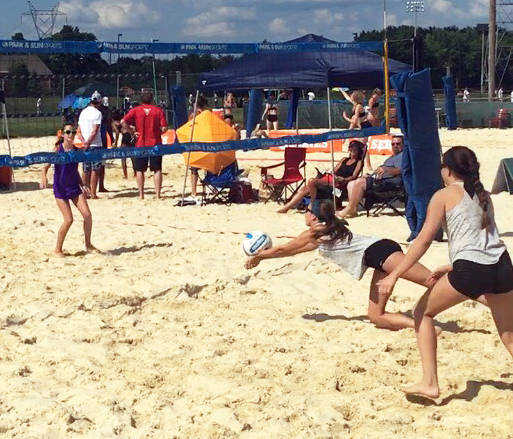No beaches, no problem: Greencastle youth succeeding in growing sport of outdoor volleyball

Indianapolis may seem like an odd spot geographically for beach volleyball to take off in popularity, given its lack of beach front property, but the Hoosier capital is becoming a hotbed for the rapidly-growing sport.
Greencastle Middle School seventh-grader Elle Patterson is emerging as a standout in the sport, teaming with Natalie Sexauer of Traders Point Academy near Indianapolis last month to win the Indy Beach Volleyball Association 13-and-under Championships.
Patterson and Sexauer, who play for different indoor teams with the Circle City Volleyball Club, teamed up to defeat eight other teams from around the country to claim the title.
Obviously, oceans are not required to play the sport; just land and sand. Still, for a team of Indiana girls to emerge victorious would have to be considered an upset over others from warm climates who can play the sport year-round.
Patterson likes both the indoor and outdoor versions of the sport, and doesn’t favor one over the other.
“Indoor volleyball is more of a team sport, where you have six players on the court at a time,” she said. “In outdoor volleyball, the court is smaller and there are two players to a team.
“You run around more, and you get more touches on the ball,” Patterson added. “Overall, it makes you better at the sport in general.”
Indoor volleyball has numerous specialists who either set, serve, spike or block in a rotating pattern of player substitutions designed to take advantage of players most adept at each particular skill.
In outdoor volleyball, you have to be good at each facet in order to be successful.
“The two sports sound similar, but they’re not,” Patterson said. “They’re different, but I like them both.”
One glaring difference between the two sports is the makeup of the court surface, and Patterson admits that jumping in the sand is difficult. And, sometimes the sand gets hot.
“I do training where I run in the sand, and jump training to make my legs stronger,” she said. “The sand can get hot, but you just have tough it out.”
A common strategy in indoor volleyball is to receive a shot from the opponent, bump it up in the air and have a front row hitter to spike it over the net. Patterson said that scenario also plays out in the outdoor game, but not as often.
“You want to be more aware of where the opposing players are on the court, and where they aren’t,” she said. “That way you can place the ball where they aren’t. You don’t necessarily want to ‘hit’ it every time, but you want to roll it over the net to an open spot.
“It’s harder to play defense than offense,” Patterson added. “At my age, both of the players stay back on the court. As you get older, one person will go up to the net and try to block while the other person stays back.”
Patterson admits that spiking and blocking are not yet her best skills in the beach version.

“I can hit [spike] the ball, but I’m not the best yet at jumping in the sand,” she said. “It’s hard to spike right now, but it will get easier as I get older.”
The inspiration
Patterson did not randomly take on a volleyball career when she began playing sports.
While some participants at the youth level are guided through various sports by well-intended parents who have limited knowledge of the skills and training required, Patterson has a good source of information in her household.
Not only did she get genetic gifts from her mother, Suzanne (Stewart) Masten, but also the training and experience her mother received while a four-year volleyball player and later an assistant coach at Purdue University.
Stewart played at Purdue from 1992-95, amassing 427 kills (29th at the time on the school’s career list), 132 total blocks (30th all-time) and 427 digs (23rd all-time) as a middle hitter and outside hitter.
Stewart received the team’s Most Improved Player Award her sophomore year and both the Coaches’ Award (for always giving 100 percent and doing whatever it takes to help the team) and the Cover Award (for getting to the most blocked hitting attempts) as a senior. Her career highs included 21 kills against Michigan (Oct. 28, 1994), six blocks (twice) and 18 digs at Northwestern (Nov. 5, 1994).
A native of LaPorte, Stewart earned her bachelor’s degree in movement and sport sciences from Purdue in 1996. She spent the first semester of the 1996-97 school year at Concordia University, an NCAA Division III school in River Forest, Ill., working on her master’s degree in gerontology and serving as a graduate assistant volleyball coach.
She was hired as an assistant coach at Purdue in January of 1997 under Hall of Fame head coach Carol Dewey and held that position for one year.
“My mom played beach for a long time, so I’ve kind of grown up around both games,” Patterson said. “I started playing beach two years ago.”
Patterson recognizes the advantage she has with such an experienced athlete as her mother.
“It’s good to have her around to help me with what I need to work on, and to improve on things,” she said. “She’s usually right when she tells me things I should do.”
Like mother, like daughter
Due to her own playing career still ongoing, Masten did not bring Elle into playing the game until she was older than most girls are when they begin their careers.
“There are kids starting at eight and nine years old, and she started at 11,” Masten said. “To see her advance, and to see her skills improve – it’s like a light bulb going off – is just amazing. She has gotten better every year, and I enjoy watching her play indoor and outdoor.”

Masten admits having a preference for beach volleyball over indoor.
“You’re outside in the fresh air, and the game is the fastest-growing sport for girls her age,” she said. “The opportunities for her in indoor and outdoor are exponential. Her outdoor game has really helped her indoor game. That is something I’ve seen this summer.”
Masten points to the all-around nature of the outdoor player as being a positive influence on indoor players whose responsibilities are fewer.
“You have to develop every skill you have in outdoor volleyball,” she said. “There’s much less help with only two players. In six on six, you can be a middle hitter and never pass the ball.
“My favorite about playing both indoor and outdoor is the cross-training,” Masten added. “You’re using different muscles in the sand, and both games help each other out.”
Masten sees an improvement in Elle’s overall play from playing both sports.
“I can tell her in playing beach that she’ll take her eye off the ball, and she knows where it needs to go,” Masten added. “Sometimes she executes, sometimes she doesn’t. Just the fact that she’s getting to that point, playing with purpose instead of just playing to play, is great to watch.”
The future
Patterson will continue to play for the Circle City travel team, whose season resumes this winter.
Despite being the most accomplished volleyball player in her grade, she won’t be playing for the school team this fall – opting instead to run cross country and work on developing her leg strength and endurance.
When Suzanne Masten was in college, beach volleyball was not an official championship sport.
The NCAA adopted the sport two years ago as an official tournament, with Southern California defeating Pepperdine this year in the final match of the eight-team event to defend its 2016 title. The other competitors were South Carolina, Hawaii, Florida State, Long Beach State, UCLA and Louisiana State.
No Butlers, no Purdues or any other landlocked colleges in the field. But that’s OK. Change is coming as the sport increases in popularity.
Masten loves the growth of the beach game, and thinks the gap is closing between coastal residents and those from the heartland.
“There aren’t a lot of places to play, but kids are finding them,” she said. “There are tournaments all over the place. Beach is growing into what indoor club volleyball is, and people are traveling across the country to play in tournaments.”
Leagues and teams are forming for younger and younger girls every year, including Masten’s 9-year-old daughter, Izzy Masten.
“The net is lower and they use a lighter ball,” Masten said. “It’s amazing what they can do at that age.”
Patterson, a straight-A student, has her eyes set on a college career someday.
“I’d like to play indoor or beach in college,” she said. “I have to make sure I work harder and do a bunch of training. My mom said I have to get As to play sports.”
Patterson knows she has a lot to work on to keep improving in both sports.
“For beach, being more aware of the court and being able to jump and place the ball where my opponents can’t get to it,” she said. “I need to work on defense and passing in both sports.”
The Midwest Sports Complex in Indianapolis has eight outdoor courts, but Masten noted the closest indoor sand courts are in Fort Wayne, Hobart and Cincinnati – each at least a two-hour drive.
For now, Masten hopes to be able to help her daughter with her jumping – without driving all the way to Indianapolis – by building a backyard sand court at their Greencastle home.
“That’s the plan,” she said.

